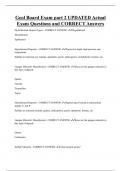Geol Board Exam part 2 UPDATED Actual
Exam Questions and CORRECT Answers
Hydrothermal Deposit Types - CORRECT ANSWER- ✔✔Hypothermal
Mesothermal
Epithermal
Hypothermal Deposits - CORRECT ANSWER- ✔✔Formed at depth, high pressure and
temperature
Sulfide ore minerals are: Galena, sphalerite, pyrite, chalcopyrite, molybdenite, bornite, etc.
Gangue Minerals: Hypothermal - CORRECT ANSWER- ✔✔these are the gangue minerals in
this type of deposit:
Quartz
Fluorite
Tourmaline
Topaz
Mesothermal Deposits - CORRECT ANSWER- ✔✔deposit type Formed at intermediate
depths, T, and P
Sulfide ore minerals include: galena, chalcopyrite, pyrite, sphalerite, bornite, etc.
Gangue Minerals: Mesothermal - CORRECT ANSWER- ✔✔these are the gangue minerals in
this type of deposit:
Quartz
Carbonates
Sulfide Minerals - CORRECT ANSWER- ✔✔what mineral group?
,Form in oxygen-poor environments
Prone to rapid oxidation and release of sulfuric acid
Major ore minerals of base metals (Cu, Pb, Zn)
Cotain S2- or S2 4-
Epithermal Deposits - CORRECT ANSWER- ✔✔what type of deposit?
Formed at shallow depths
Relatively low T and P
Sulfide ore minerals include: realgar, cinnabar, acanthite, pyrite, orpiment, stibnite, sphalerite,
proustite, pyragitite
Sulfide Minerals - CORRECT ANSWER- ✔✔what groupd does this minerals belong?
Pyrite, Chalcopyrite, marcasite, galena, pyrrhotite, cinnabar, arsenopyrite, stibnite, realgar
Marcasite (FeS2) - CORRECT ANSWER- ✔✔Streak = grayish black, hardness 6-6.5,
Specific gravity = 5.89
Arsenopyrite (FeAsS) - CORRECT ANSWER- ✔✔Derivative structure of marcasite; half of
S is replaced by As
Streak = black, hardness 5.5-6, S.G. = 6.07
Chalcopyrite (CuFeS2) - CORRECT ANSWER- ✔✔Streak = greenish-black, hardness = 3.5-
4, Specific gravity = 4.1-4.3
Galena Pbs - CORRECT ANSWER- ✔✔Streak = lead gray, hardness = 2.5, specific gravity
= 7.4-7.6
Cinnabar (HgS) - CORRECT ANSWER- ✔✔Streak = scarlet, hardness = 2.5, specific
gravity = 8.10
,Sphalerite (ZnS) - CORRECT ANSWER- ✔✔streak = lead-grey to black, hardness = 2,
specific gravity = 4.52-4.62
Stibnite (Sb2S3) - CORRECT ANSWER- ✔✔Streak = lead-grey or black, hardness = 2,
specific gravity = 4.52-4.62
Realgar (AsS) - CORRECT ANSWER- ✔✔streak = red-orange, hardness = 1-1.5, specific
gravity = 3.48
Tubulite (Ag2Pb22Sb20S53) - CORRECT ANSWER- ✔✔tubular morphology; capillary
action or aliens?
Strong acids and bases - CORRECT ANSWER- ✔✔HCl
LiOH
KOH
HNO3
Weak acids and bases - CORRECT ANSWER- ✔✔CH3COOH
NH3
H2O
Sulfides - CORRECT ANSWER- ✔✔Major ore minerals
Form in oxygen poor environments
Prone to rapid oxidation and release of sulfuric acid
Most are opaque
Streak Color important for identification
General Formula XmSn
Sulfide ore Minerals - CORRECT ANSWER- ✔✔Sphalerite
Galena
Cinnabar
, Molybdenite
Bornite
Argentite
Acanthite
Efflorescent Salts - CORRECT ANSWER- ✔✔Rapid evaporation of ferrous sulfate solutions
Results in soluble salts
Supergene Minerals - CORRECT ANSWER- ✔✔what deposits type minerals are these?
Melanterite
Rozenite
Szomolnokite
Uranyl Silicate - CORRECT ANSWER- ✔✔Most common secondary uranyl mineral group
Framework silicates - CORRECT ANSWER- ✔✔U:Si = 2:5
Haiweeite
Weeksite
Soddyite
Bragg's Law - CORRECT ANSWER- ✔✔n*lamdba = 2*dsin(theta)
Used to determine positions of atoms by how they diffract rays --> had spacing of the layers
Relate the ratios of the wavelengths of the rays to the spacing between layers and how that
relates to the angle of incident beams
n = whole number series when waves of different layers are in phase with one another
Mathematics to find patterns of diffraction related to spacing between layers




